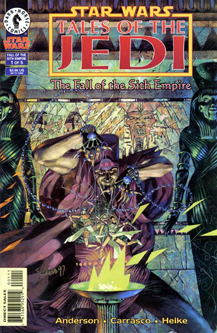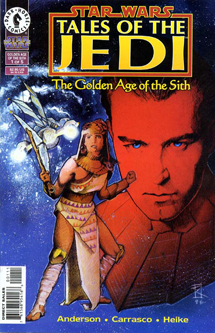Similar to following evolutionary theory backward to the Big Bang, “Star Wars” stories always seem to have a backstory, no matter how far back on the timeline they take place. 1993’s “Tales of the Jedi,” which takes place 4,000 years before “A New Hope,” aimed to give some historic flavor to the Force. But writers Tom Veitch and Kevin J. Anderson (who took the reins on the “TOTJ” sequels) inevitably gave this backstory a backstory.
The result is Anderson’s “Golden Age of the Sith” (1996-97) and “Fall of the Sith Empire” (1997), two five-issue series that take place 5,000 years before “A New Hope.” Providing the art, as he did for Anderson’s “The Sith War,” is Dario Carrasco Jr. He does solid work, although I slightly prefer original “TOTJ” artist Christian Gossett, who will return for the final chapter, “Redemption.”
There are two familiar faces here: The Sith Lord Naga Sadow, who aims to expand his Sith Empire into Republic space, and the Jedi Odan-Urr, who is a youngster here, although he’s always been an old soul who prefers to read and learn about the Force in a library setting.

The most compelling aspect of the “TOTJ” prequels is the idea of discovering hyperspace lanes. Similar to Earth explorers who ventured across the Atlantic not knowing when they’d strike land, brother and sister Gav and Jori Daragon search for safe hyperspace routes they can map and sell. This basically consists of spinning a dial in the cockpit of their Starbreaker 12 and crossing their fingers.
When the siblings stumble upon Sith space, they unwittingly give Sadow access to Republic space, since the navigational data is stored in the ship’s computer. In Sith space, we learn more about Sith culture. At this point in “Star Wars” lore, many readers were confused about whether the phrase “dark lord of the Sith” meant “a lord who is a Sith” or “one who lords over the Sith species.” It turns out that both are correct, at least in these yarns. Sadow and all of the Sith lords of this time and location (Korriban is the Sith homeworld) seem to be humans interbred with Sith, giving them reddish skin. There are also pure-blooded lower castes of Sith (also known as Massassi) –animalistic, good sources of labor, but not Force-sensitive — whom the lords rule over.
“Golden Age” is better than the somewhat-padded “Fall,” but in general, both series spend too much time with the siblings missing each other (Sadow keeps them in different cells) and Jori fretting over how to warn Empress Teta, the ruler of the Daragons’ home system that will be targeted by Sadow.
Conversely, Anderson skims over what could’ve been an interesting theme: Teta has united six planets in the system that bears her name, but the seventh prefers to remain independent. Via military action, she of course “unites” the seven planets. Although there’s a lot of talk about “unification” and “peace” and “prosperity,” Teta is obviously a warmonger, an Abraham Lincoln figure who will be given a positive spin in the history books.

Meanwhile, some Sith Lords prefer not to attack Republic space. Thus, Anderson sets up the notion of the good guys being not so good and the bad guys being not so bad. (The author seems intrigued by the idea of going against type in these two series. Another example is the Daragons’ Hutt boss, Aarrba, who is actually a nice guy.) However, he doesn’t delve deeply into the gray areas as the story builds toward a streamlined ending.
Like a lot of prequels, the final pages lock into place with the stories that are to follow. The Empress Teta system is united, Odan-Urr determines to set up a Jedi library on Ossus and settle in for a millennium of curling up with good books, and Naga Sadow begins construction of the pyramidal temples on the uninhabited Yavin 4 using his Massassi slaves (hence the term “Massassi temples”).
Ultimately, “Golden Age of the Sith” and “Fall of the Sith Empire” aren’t as bad as you may have heard, but they aren’t essential “Star Wars” reading. They are nice bonus material for fans who really dig the “Tales of the Jedi” saga.

